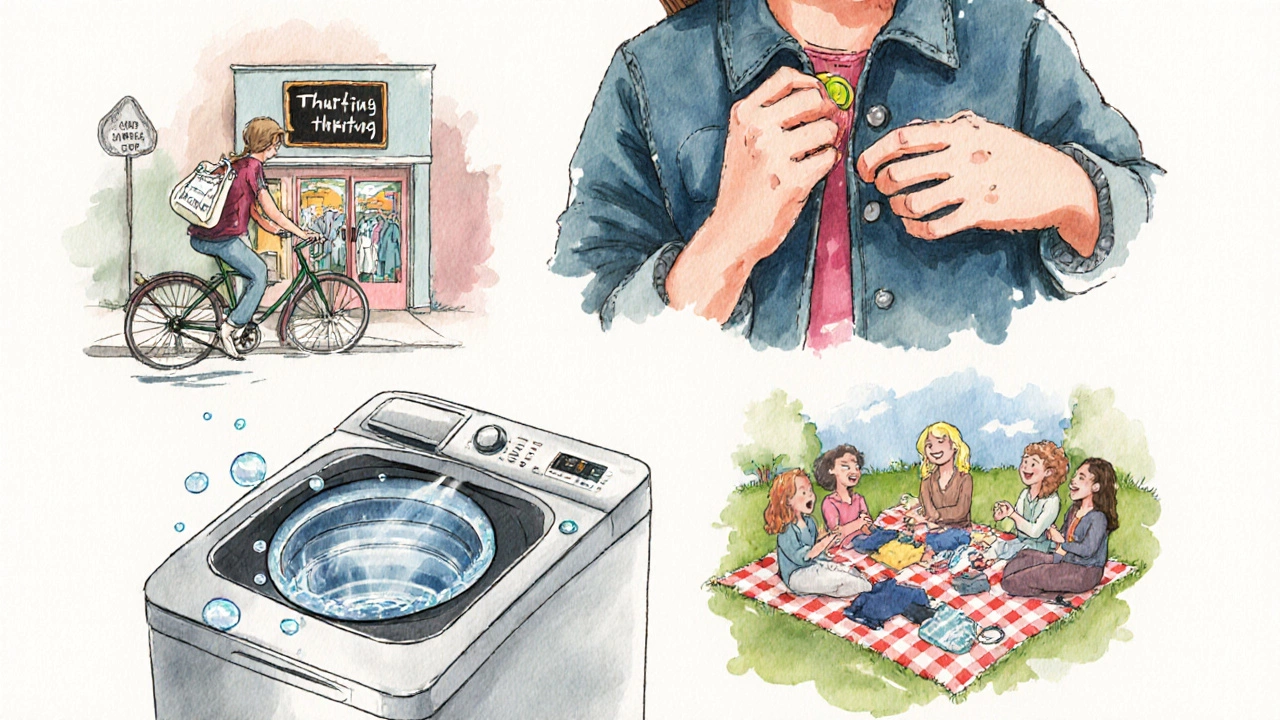Carbon Impact Calculator
How many secondhand items did you buy this year?
The average item saves 6kg CO2e (based on University of Cambridge study)
Your Impact
kg CO2e saved
Equivalent to miles driven
Calculation based on 6kg CO2e per item (average from University of Cambridge study)
Does not include transportation or care-related emissions
When people wonder whether thrifting counts as sustainable fashion, they’re really asking if buying pre‑owned clothes can cut the environmental damage caused by the apparel industry. The answer isn’t a simple yes or no - it depends on how you shop, what you buy, and the wider systems that move garments from racks to wardrobes.
What thrifting actually means
Thrifting is the practice of purchasing secondhand clothing from charity shops, thrift stores, consignment boutiques, online resale platforms, or garage sales. It emerged from the need to stretch limited budgets, but it has become a cultural movement tied to sustainability, vintage aesthetics, and unique style.
Defining sustainable fashion
Sustainable fashion refers to an approach that minimizes negative environmental, social, and economic impacts throughout a garment’s lifecycle, from raw material extraction to end‑of‑life disposal. The core pillars include reducing carbon emissions, conserving water, limiting chemical use, ensuring fair labor, and fostering circularity.
Why fast fashion hurts the planet
Fast fashion is the antithesis of circularity. Brands churn out new collections every few weeks, encouraging disposable consumption. According to the Ellen Ewing Foundation, the fashion sector accounts for about 10 % of global carbon emissions - more than international flights and maritime shipping combined. Each cotton t‑shirt can require up to 2,700 liters of water, enough for one person’s drinking needs for two and a half years. Moreover, textile waste is soaring; the EPA reports that over 11 million tons of textile waste ended up in U.S. landfills in 2022 alone.
How thrifting cuts down environmental impact
When you buy a secondhand piece, you’re essentially extending the life of an already‑produced garment. This saves the raw materials, energy, and water that would have been needed to make a new item. A 2023 study from the University of Cambridge estimated that each reused garment can avoid emitting roughly 5-8 kg of CO₂e, depending on the fabric type. For denim, the saving can be as high as 22 kg CO₂e per pair of jeans.
Beyond carbon, thrifting reduces textile waste. If a used shirt stays in circulation for another five years instead of being shredded, that’s five fewer items ending up in landfill each year. The circular economy framework, which emphasizes keep‑value‑in‑use, aligns perfectly with the secondhand market.

When thrifting might not be sustainable
Despite the clear benefits, not every thrift purchase is automatically green. Several factors can erode the environmental advantage:
- Transportation footprint: Driving long distances to a thrift store or ordering from overseas resale platforms can add significant emissions, especially if items are shipped via air freight.
- Cleaning and repair: Frequent dry‑cleaning of delicate vintage pieces uses harsh chemicals and water. Opting for eco‑friendly laundering methods mitigates this.
- Overconsumption: The thrill of the hunt can lead to buying more than you need, offsetting the savings from reusing garments.
- Quality of the garment: Low‑quality items that fall apart quickly may end up discarded sooner, reducing the net benefit.
Comparing the footprints: Thrifting vs. Fast fashion
| Metric | Fast Fashion Item | Thrifted Item (reuse) |
|---|---|---|
| CO₂ Emissions (kg CO₂e) | ≈ 12 - 30 | ≈ 1 - 5 |
| Water Use (liters) | ≈ 2,000 - 5,000 | ≈ 0 - 200 (laundry only) |
| Landfill Waste (kg) | ≈ 0.5 - 1 | ≈ 0 (if kept >5 years) |
| Average Lifetime (years) | ≈ 1 - 2 | ≈ 3 - 7 |
These numbers are averages; actual figures vary by material, manufacturing location, and consumer behavior. Still, the table shows a clear advantage for reusing garments.
Practical tips to make your thrifting habit truly sustainable
- Plan your trips: Combine thrift shopping with other errands, use public transport, or choose stores within walking distance.
- Buy quality over quantity: Look for well‑made items made of natural fibers like organic cotton, linen, or wool that last longer.
- Repair before you replace: Learn basic sewing skills or use local tailors to fix small tears and missing buttons.
- Launder responsibly: Wash in cold water, air‑dry when possible, and use eco‑friendly detergents.
- Donate or swap: When you no longer need a piece, give it to a charity shop, organize a clothing swap, or list it on a resale platform.
- Check the supply chain: Some thrift stores partner with brands that ensure ethical sourcing and minimal chemical use. Look for certifications like Fair Trade or GOTS.

Beyond thrifting: Building a circular wardrobe
Thrifting is just one tool in the circular economy toolbox. To push your closet further toward sustainability, consider these additional strategies:
- Upcycling: Turn an old denim jacket into a bag or patchwork shirt.
- Rental services: For special occasions, rent a dress instead of buying one you’ll wear once.
- Swap parties: Host gatherings where friends exchange clothes they no longer wear.
- Zero‑waste tailoring: Choose retailers that offer made‑to‑measure garments with minimal waste.
These practices keep fabrics in use, cut down on new production, and reduce overall resource consumption.
Common myths about thrifting and sustainability
Myth 1: All secondhand clothes are automatically eco‑friendly. Not true - the environmental benefit depends on the item's durability, the distance it travels, and how it’s cared for.
Myth 2: Thrifting is only for vintage lovers. While vintage is popular, many thrift stores carry contemporary basics that can replace fast‑fashion staples.
Myth 3: Fast fashion and thrift stores have the same impact. Fast fashion creates new garments each season, driving high emissions and waste. Thrift stores mainly extend the life of existing garments.
Measuring your personal impact
If you want to see how much you’ve helped, use a simple calculator:
- Count the number of secondhand items you’ve bought in the past year.
- Multiply each by an average CO₂ saving of 6 kg (midpoint of the study range).
- Sum the result - that’s the approximate kilograms of CO₂ you’ve avoided.
For example, buying 20 thrifted shirts saves roughly 120 kg of CO₂e, equivalent to the emissions from driving a car about 300 km.
Conclusion: The nuanced truth
Thrifting can be a powerful lever for sustainable fashion, but only when practiced mindfully. By choosing quality pieces, minimizing travel emissions, caring for garments responsibly, and integrating other circular practices, you turn a simple shopping habit into a meaningful climate action.
Does buying secondhand always reduce carbon emissions?
Not always. The carbon saving depends on the garment’s original production impact, the distance it travels to reach you, and how you care for it. Shipping by air or frequent dry‑cleaning can offset some of the benefits.
What fabrics are best to look for when thrifting?
Natural fibers like organic cotton, linen, Tencel, and wool tend to be more durable and easier to recycle. They also have lower microplastic shedding compared to synthetic fabrics.
How can I reduce the transportation impact of thrift shopping?
Shop at local charity shops, combine trips with other errands, use public transport or bike, and consider online platforms with consolidated shipping options.
Is it better to buy new sustainable brands than to thrift?
Both approaches have merit. New sustainable brands can offer transparent supply chains and lower chemicals, but they still require fresh resources. Thrifting avoids new production entirely, making it generally lower‑impact if the item is high‑quality and kept long‑term.
How often should I clean my thrifted clothes?
Follow the same guidelines as for any garment: wash in cold water, avoid over‑drying, and spot‑clean when possible. If the item is heavily soiled, consider a gentle hand wash rather than dry‑cleaning.
